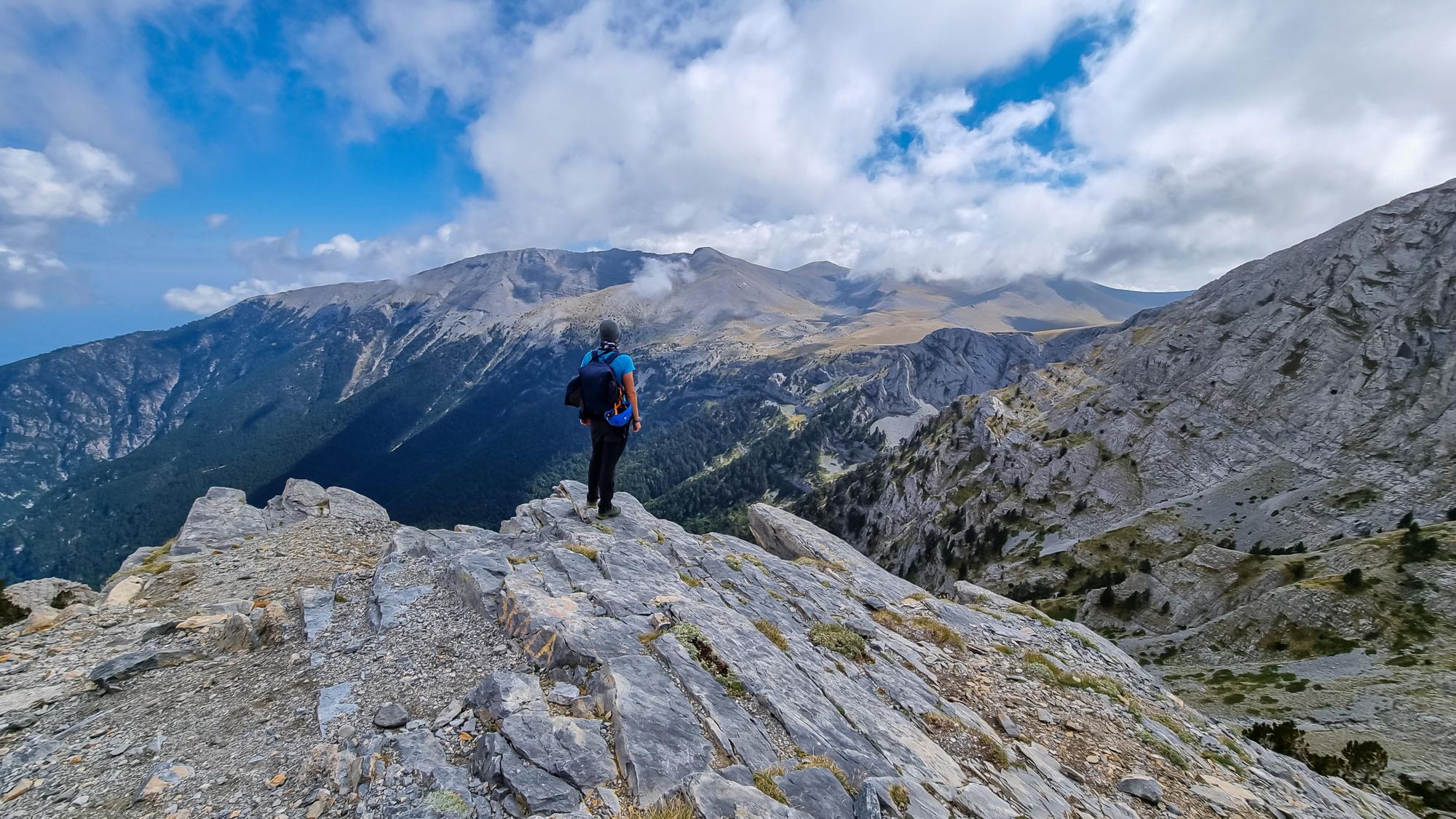Mount Olympus is the highest peak in Greece; a bulking mountain topped by rugged, pointing rocks which pierce the sky. Olympus sits on the Thessaly-Macedonian border and the top of the mountain, which is only reachable by a tricky scramble, looks out to the Aegean Sea. But what is the best route to reach the summit of Mount Olympus?
In this article, we’re going to look in detail at the route to the top of this storied mountain, which is famous in mythology as being the home of the 12 Olympian Gods - from Zeus and Hera to Poseidon and Aphrodite. We're going to detail the route, at the heart of Olympus National Park, and describe the trek up Olympus.
I've been up to the summit more than 100 times in the last five years, but it is different every time.
In order to get an expert voice involved, we got in touch with Athanasios Pitenis, a local guide who grew up beneath Mount Olympus, and who is perfectly positioned to offer expert commentary. “I've been up to the summit more than 100 times in the last five years,” he says. “But it is different every time.”
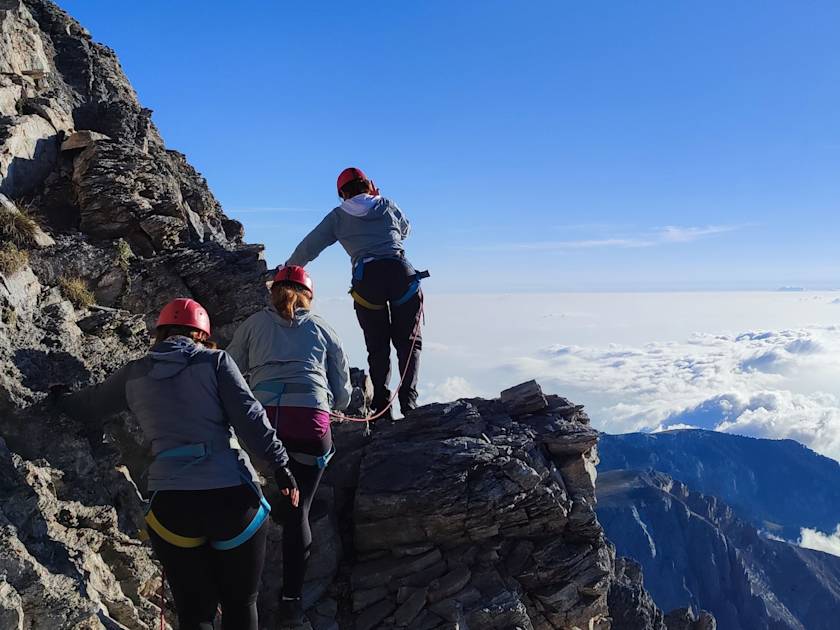
First, though? A TL;DR-style answer to the question. In our opinion, the best route up Mount Olympus is a mish-mash of various popular trails - starting on the E4 route, overnighting at the Muses Plateau and then continuing on to the summit in the morning, before descending on a different path down to Gortsia. Now, let’s look at that route up Mount Olympus - step by step, with an expert.
We must note that this is only a vague guide, to give you an idea of the route up Olympus. Hire an expert local guide for safety, as this route can be dangerous.
What is the Best Route up Mount Olympus?

- Start point: Prionia
- End point: Gortsia
- Distance: 15 miles (24km)
- Duration: 2 days
- Altitude: roughly 1,800 (5,905ft) up, and 1,800m (5,905ft) down
- Highest peak of Olympus: Mytikas (2,918m)
The stats above are for the full route, which can be broken into four sections:
- The E4 Route: This popular walking route runs from Prionia (1,100m/ 3,609 ft) up to the Spilios Agapitos Refuge (2,040m/6,692ft). It’s a 2.8 mile (4.5km) trek and usually takes around three hours to walk. The E4 route on Olympus is actually a small part of the much larger E4 international hiking path. To spend the night on the Muses Plateau, leave the E4 and head for either the Giosos Apostolidis or Christos Kakkalos refuges - 90 minutes further.
- Muses Plateau to Skolio and Mytikas (The Zonoria Path): This is the route to the summit, heading onwards to the daunting crossing of the Zonaria of Mytikas. This leads you to the base of Louki of Mytikas, where you will scramble to Mytikas, before returning to the refuge where you slept the night previous. A loop will lead you back to the Muses Plateau.
- Muses Plateau to Petrostrougka to Gortsia: This 8.3-mile (13.4km) route leads back down to the base of the mountain. You’ll cross a narrow ridge called Laimos, leaving the plateau, and come to Petrostrouga, where there are old Bosnian pines. Leaving the alpine landscape behind, you’ll walk through beech forest and down a wide path to your exit point.
Here’s a more detailed look at day one and day two, on the climb of Olympus.
Day 1: Prionia to the Muses Plateau

- Duration: 8-9hrs
- Distance: 7.5 miles (12km)
- Ascent: 1,600m (5249ft) up
“We hike to the top in two days,” says Athanasios. “The trail starts from Prionia at 1,100m. That’s the end of the road - where we park our mini vans and prepare for the hiking.
“We start on a popular route called E4. E4 is a long distance path which continues up to the Agapitos Refuge at 2,060m. The first part of our route, the first day, is 6.5km with more than 1,000 metres of ascent. It’s in forest terrain, then after two hours we have a trail between forest and rocks. It’s medium difficulty but every hour we have a small stop for one or two minutes just to take a break and enjoy the view and speak about the flora and fauna and mythology.
We start hiking through black pine forest and we overnight in alpine meadows without forest, with only the high peaks, the stones, the flowers and stars around.
“Above 1,600m we have robelo forest, which is Bosnian pine. It's completely different from the other kind of black pine forest. The main forest is the black pine forest. You’ll see it everywhere, but we also have some beech trees."
Much of this is on switchbacks. Athanasios continues: “We need three to four hours to get to the Agapitos Hut, where we can then stop to refill our bottles and eat or drink something. The Agapitos Hut is the biggest and the most organised mountain hut in Greece.
"The first night we then walk on to reach Muses Plateau, at 2,600m."
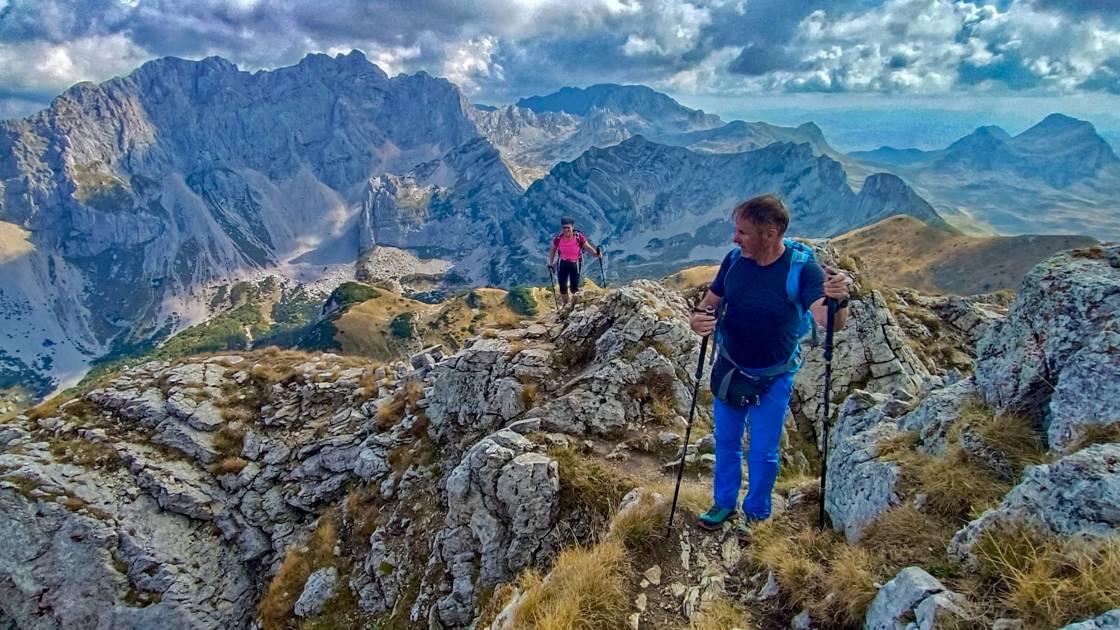
From the Agapitos Hut, the route continues on the E4 before switching paths.
“We continue above the forest zone, from 2,200m and up. We follow the E4 path for one more hour before switching onto the famous Zonaria path. This is a rocky path in the alpine zone of the mountain. You have amazing views. On your right hand, you can look down to the robelo forests, over the national park and to Litochoro and the Aegean Sea. On your left hand, you have the highest peaks of the mountain - like Scala, the fourth highest, and Mytikas, the highest.
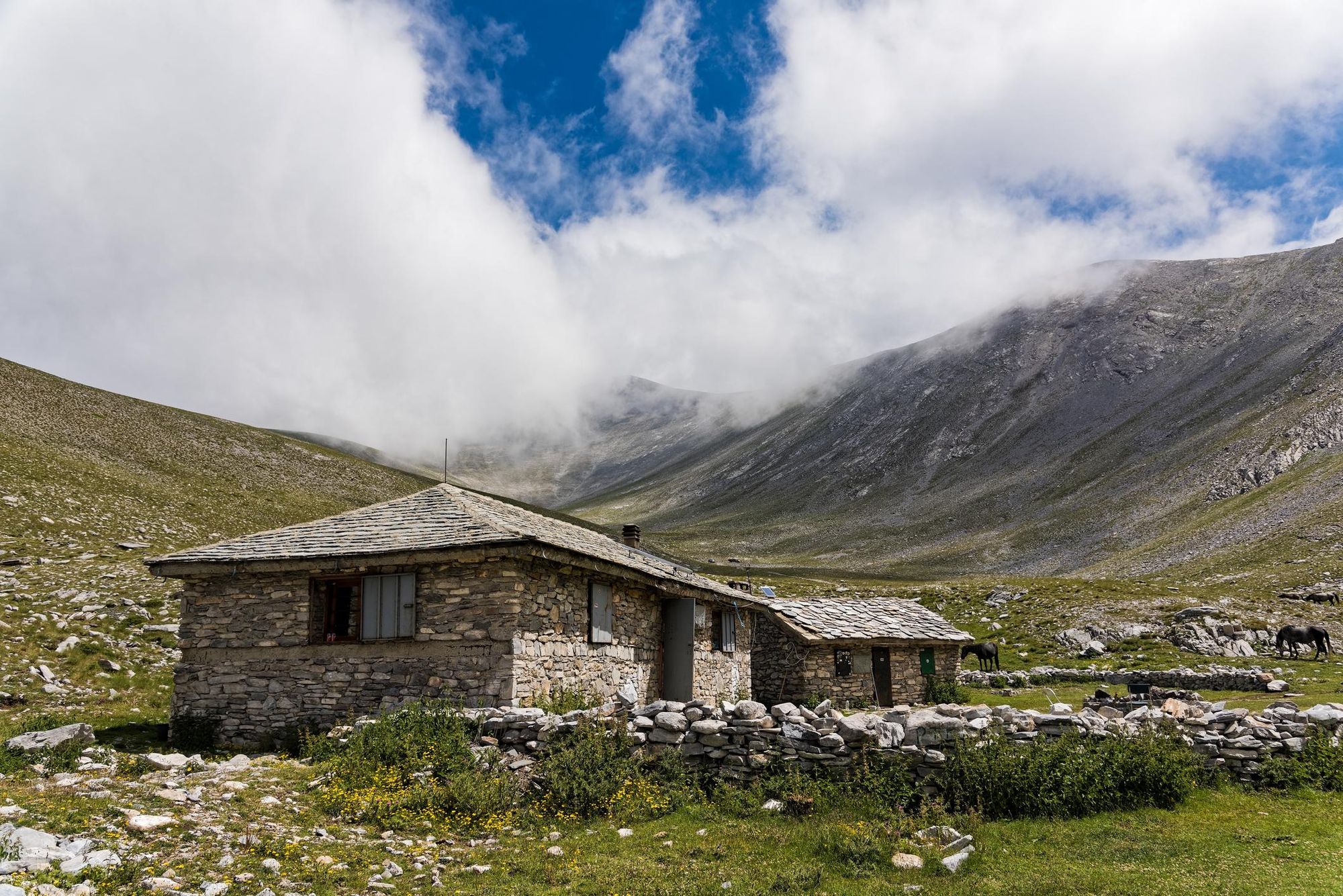
“We continue to hike this beautiful traverse for 2.5km and then after a big turn, we have in front of us the Muses Plateau, where we're accommodated at the Giosos Apostolidis Hut, the highest hut in the Balkans at 2,700m, or at Christos Kakkalos Refuge at 2,648m. So for the first day we have more than 10km hiking, more than 1,700m ascent, but we have amazing views from all over the mountain. We start hiking through black pine forest and we overnight in alpine meadows without forest, with only the high peaks, the stones, the flowers and stars around.” This concludes the first day of trekking up Mount Olympus.
Day 2: Muses Plateau to Summit and Down

- Duration: 8-9hrs
- Distance: 7.5 miles (12km)
- Ascent: 268m (879ft) up
- Descent: 1,800m (5,905ft) down
Typically, you will leave your refuge at 7am in the morning to begin the summit hike to Mytikas and the top of Greece. Crossing the Zonaria of Mytikas on a stable, wide path, you’ll reach the base of Louki of Mytikas, where the scramble begins. You’ll ascend a series of slopes and natural steps - with the third of the four steps being the toughest of the scrambles.
It will usually take about 45 minutes of careful ascending to beat Louki and reach Mytikas, and you need to use safety equipment here; specifically a helmet.
“If a member of our team doesn’t feel well when we’re approaching Mytikas, or doesn’t want to climb it, then we can approach Skolio instead - which is completely different,” says Pitenis. Skolio is the fourth highest peak on Mytikas, at 2,911m (9,551ft). It is a less technical peak, and so better for those with vertigo.
There's the northern reaches of the mountain, the snow patches around the valleys and the most amazing view is of the Aegean sea...
“It’s a smoother peak. You don't need equipment and you don't need to scramble. For the last part of Mytikas it is scrambling - not climbing, but scrambling. This is the difference. Mytikas is the highest peak and you must use equipment. You must not be afraid of heights. Skolio is more like hiking, and you don't have the safety equipment.” The view on top of either summit is superb.
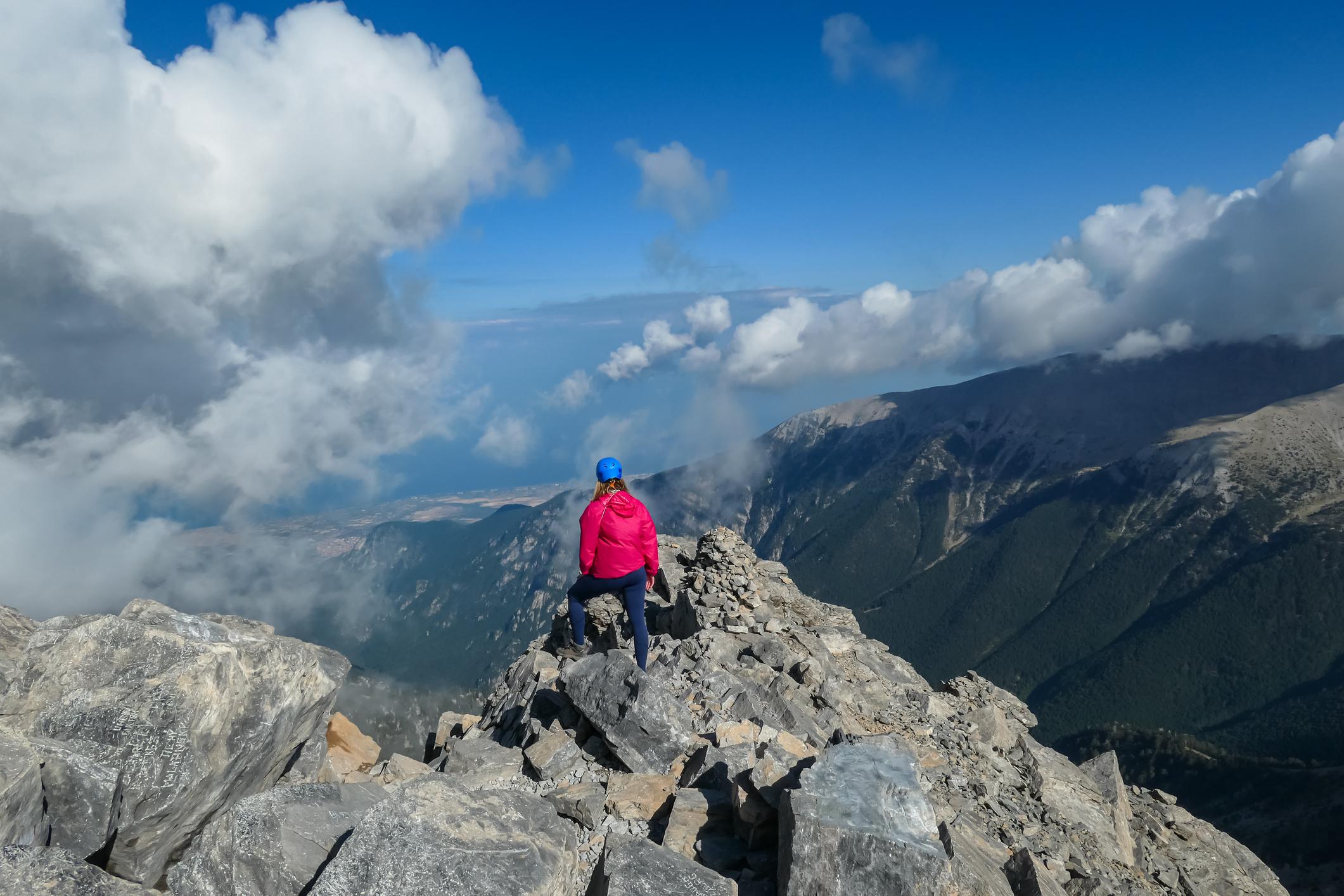
“It’s 360 degrees,” says Athanasios, of the view from the top of Mytikas. “First we look around for the 12 Gods. Then we’ll see the southern slopes, which are smoother, and the northern reaches of the mountain, the snow patches around the valleys and the most amazing view is of the Aegean sea.”

Rather than descending the E4 route, Pitenis prefers to walk a different trail.
“We descend to Gortsia, which is only 4km away from Pironia, but which means you see a new side of the mountain,” he says. “After Mytikas, you actually go back to the hut first, relax and prepare your stuff again, and then we continue. We leave the Muses Plateau and you’ll find 2.5km of mountain reeds, and you can still see the Aegean Sea. It's a completely different landscape, left and right. You'll pass Petrostrouga Hut, where you refill your water bottles and prepare your muscles and your knees for the last part.”
This is an area with old Bosnian pines. You continue down from here, leaving the high mountain views behind. On this route, you can visit the cave that was once home to Vasilis Ithakisios, a renowned Greek painter known for his ethnographic themes and images of Olympus. You’ll pass through beech forest on your way to the exit, which connects to the Liochoro-Prionia road.
Inspired? Climb Mount Olympus (2,918m) on a three-night adventure!

